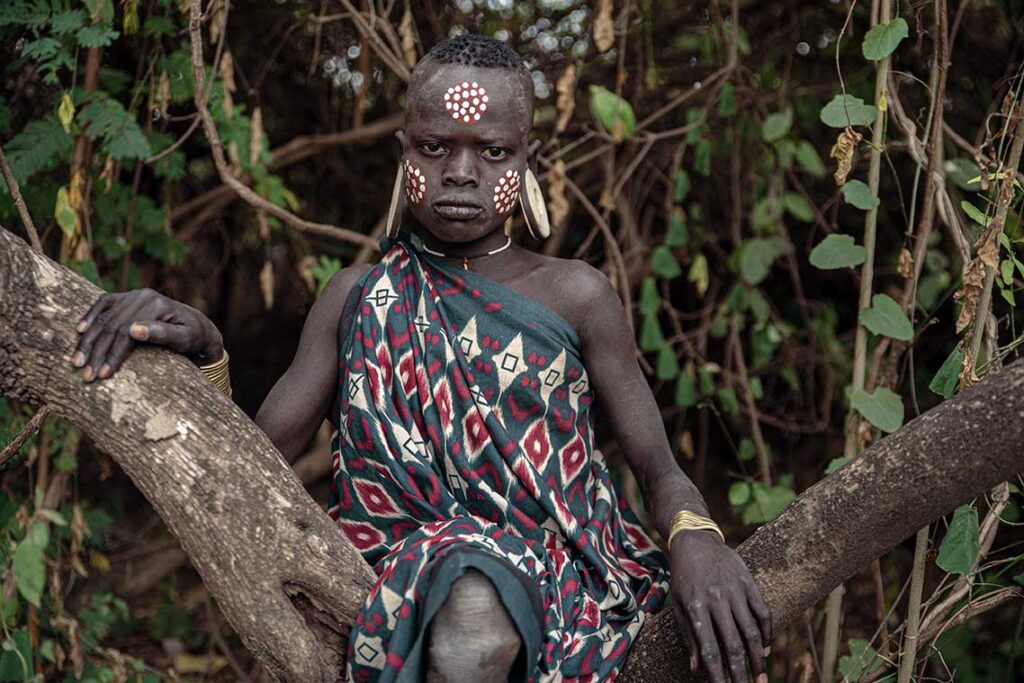Biljana Jurukovski
Culture Of The Mursi Tribe
Mursi, or Mursu or Mun as they refer to themselves, are a Nilotic pastoralist ethnic group in Ethiopia. Their territory of around 2,000 km2 lies in the South Omo Zone of the Southern Nations, Nationalities and Peoples’ Regional State (SNNPRS), roughly between the Rivers Omo (Warr) and Mago (Mako), close to the border with South Sudan. According to the 2007 national census, there are 7,500 Mursi, 448 of whom live in urban areas. Surrounded by mountains between the Omo River and its tributary, the Mago, the home of the Mursi, is one of the country’s most isolated regions. Due to the climate, they move twice a year between the winter and summer. They herd cattle and grow crops along the banks of the Omo River.

The Mursi is considered to be one of the most feared tribes that still exist today. Living in an isolated area of the Lower Omo Valley in Ethiopia has equated to this community remaining inaccessible until a few years ago. The unconventional journey to get to their current location reinforced their seclusion from the contemporary world. Centuries of isolation have enabled the Mursi tribe to reach the present day with almost completely unchanged traditions and rituals, in which I had the privilege of being immersed. One enduring ritual has been the adornment of numerous jewels and accessories that serve as both an aesthetic ornament and delineate an individual’s social contacts.
For this tribe, body painting is performed for aesthetic appeal, symbolic representation, and as a tool to protect and heal themselves. Much like many other acts performed by the tribe, it was multi-purpose and rooted in tradition. Mursi is also known for their elaborate skin scarification and for wearing a lip plate.
In the tribal culture of Mursi, there are two types of scarifications: kitchoga and riru: both different in purpose and meaning, with riru, for example, only reserved for men. Women carve their bodies to get this ornamental scar on the abdomen, chest, back, and arms; the practice begins at the age of puberty, when the appearance of the breast forms, and ends when a girl gives birth to her first child.

Another important distinguishing feature of the Mursi culture is the practice of women wearing lip plates made of clay or wood. The ritual of inserting the lip plate starts when the girl reaches the age of 15 or 16 when her mother makes a small incision just below her lower lip, and a small disk is inserted inside this incision that is worn for a few months, the time necessary for the cut wound to heal. Today many girls refuse to make the incision, so it has become a tradition that is slowly dying out.
Biljana Jurukovski
“It is said that a woman who does not wear a lip plate is considered lazy and will not warrant as large a bridewealth (a dowry that usually consists of a certain number of cattle). With some lip plates reaching up to 12 centimeters in diameter, it is undoubtedly a mark of perseverance and bravery on behalf of the woman who wears it.“

Biljana Jurukovski is a Macedonian Australian Award-Winning Photographer who has been inspired and amazed by different cultures’ diverse and beautiful expressions.
She enjoys traveling to remote destinations to learn about indigenous people’s cultures and traditions and photograph them.
Biljana’s portraits are a culmination of her passion, love, and respect for other cultures and traditions; they depict a graceful world where strength and pride are engraved on the faces of the people photographed.
Through photography, she aims to create discussions about different cultures, their way of living, and accepting life challenges. In addition, Biljana sees photography as a medium for communication between people.
Biljana’s work has been exhibited in UAE, New York, Paris, Berlin, Barcelona, and Macedonia and published in many magazines, newspapers, and websites, including The Guardian, Lens Magazine, Sydney Morning Herald, La Fotografia Magazine, EYS magazine, Silvershootz Magazine, Dek Unu Magazine and many more.








